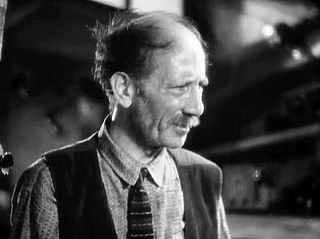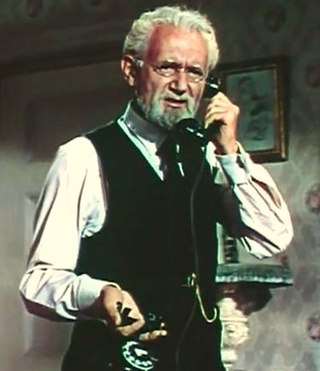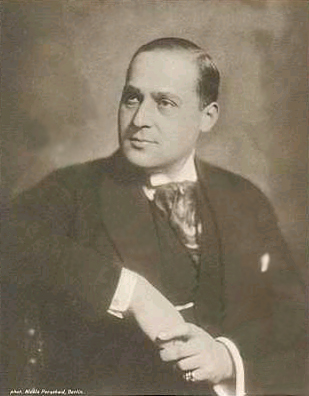
Paul Henreid was an Austrian actor, director, producer, and writer. He is best remembered for two film roles: Victor Laszlo in Casablanca and Jerry Durrance in Now, Voyager, both released between 1942 and 1943.

Hans Walter Conrad Veidt was a German-born British actor. He attracted early attention for his roles in the films Different from the Others (1919), The Cabinet of Dr. Caligari (1920), and The Man Who Laughs (1928). After a successful career in German silent films, where he was one of the best-paid stars of UFA, Veidt and his new Jewish wife Ilona Prager left Germany in 1933 after the Nazis came to power. The couple settled in Britain, where he took citizenship in 1939. He appeared in many British films, including The Thief of Bagdad (1940), before emigrating to the United States around 1941, which led to his being cast in what may be his best remembered role as Major Strasser in Casablanca (1942). This was Veidt's last film role to be released during his lifetime.

Helmut Dantine was an Austrian-American actor who often played Nazis in thriller films of the 1940s. His best-known performances are perhaps the German pilot in Mrs. Miniver and the desperate refugee in Casablanca, who tries gambling to obtain travel visa money for himself and his wife. As his acting career waned, he turned to producing.

Egon Brecher was an Austria-Hungary-born actor and director, who also served as the chief director of Vienna's Stadttheater, before entering the motion picture industry.

Ludwig Donath, was an Austrian actor who appeared in many American films.

Rudolph Anders was a German character actor who came to the United States after the rise of Hitler, and appeared in numerous American films in the 1940s, 1950s, and 1960s.
Hans Heinrich von Twardowski was a German film actor.
Trude Berliner was a German actress. She was one of many Jewish actors and actresses who were forced to flee Europe when the Nazis came to power in 1933.

Ludwig Stössel was an actor born in Lockenhaus, now Austria, then Hungary. He was one of many Jewish actors and actresses who were forced to flee Germany when the Nazis came to power in 1933.

Ilka Grüning was an Austrian-Hungarian actress. Born in Vienna in the old Austrian-Hungarian Empire, she was one of many Jewish actors and actresses that were forced to flee Europe when the Nazis came to power in 1933. A respected and famous actress of her time in the German-language area, she was forced to play bit parts in Hollywood.

Louis V. Arco was an Austrian stage and film actor whose career began in the late 1910s.

Christian Rub was an Austrian-born American character actor. He was known for his work in films of the late 1910s to the early 1950s, and was featured in more than 100 films.

Martin Kosleck was a German film actor. Like many other German actors, he fled when the Nazis came to power. Inspired by his deep hatred of Adolf Hitler and the Nazis, Kosleck made a career in Hollywood playing villainous Nazis in films. While in the United States, he appeared in more than 80 films and television shows in a 46-year span. His icy demeanor and piercing stare on screen made him a popular choice to play Nazi villains. He portrayed Joseph Goebbels, Adolf Hitler's propaganda minister, five times, and also appeared as an SS trooper and a concentration camp officer.

Wolfgang Zilzer was a German-American stage and film actor, often under the stage name Paul Andor.

Chetniks! The Fighting Guerrillas is a war film made by Twentieth Century Fox in 1943. The film starred Philip Dorn, Anna Sten, and Martin Kosleck.

Sven Hugo Borg was a Swedish-American character actor.
The Hitler Gang is a 1944 American pseudo-documentary film directed by John Farrow, which traces the political rise of Adolf Hitler. Described as a "documentary-propaganda" film by its studio, Paramount Pictures, the historical drama is based on documented fact and marks the first serious effort to portray Hitler in film. The filmmakers chose to avoid casting stars in the lead roles, assembling instead a remarkable company of lookalikes to play Hitler, Goebbels, Himmler, Göring, and other leading Nazis.

Bobby Watson was an American theater and film actor, playing a variety of character roles, including, after 1942, Adolf Hitler.

John Mylong, also known as Jack Mylong-Münz, born Adolf Heinrich Münz, was an Austrian actor who later settled in the United States.

Felix Basch (1885–1944) was an American-Austrian actor, screenwriter and film director.
















